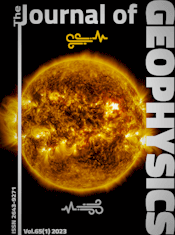The canonical decomposition and its relationship to other forms of magnetotelluric impedance tensor analysis
Article Sidebar

Vols. 1-18 (1924-1944), ISSN 0044-2801
Main Article Content
Abstract
A technique for magnetotelluric (MT) data analysis, known as the canonical decomposition, is developed from first principles. This analysis is based on the canonical decomposition of the impedance tensor Z and explicitly parametrizes Z in terms of eight physically relevant structural parameters which specify the transfer characteristics of the Earth system (i.e. the maximum and minimum principal apparent resistivities and the associated principal phases) as well as the principal or intrinsic coordinate system for Z (i.e. the two principal orthogonal electric and magnetic field polarization states). It is shown that the formulation of canonical decomposition in which the polarization descriptors are specified in terms of elliptic parameters results in the MT impedance tensor analysis presented by LaTorraca et al. The relationships between canonical decomposition and several other forms of magnetotelluric data analysis are explored. Specifically, we compare the canonical decomposition with the "conventional" analysis, the maximum coherency analysis, the associate and conjugate directions analysis developed by Counil et al., Eggers' eigenstate analysis and Spitz's rotation analysis. It is shown that canonical decomposition is a natural generalization of the conventional analysis in that both the rotation and ellipticity properties of Z are utilized in the definition of a principal coordinate system. A generalization of the maximum coherency analysis is shown to yield the same parameters as those extracted in canonical decomposition. By imposing a specific restriction on the generalized maximum coherency analysis, we next show how to extract the parameters (i.e. the directions of maximum and minimum current and induction and the corresponding electric and magnetic sheet impedances) that were obtained by Counil et al. in their associate and conjugate directions analysis. The relationship between canonical decomposition and Eggers' eigenstate analysis is developed and it is shown that the primary deficiency in the eigenstate formulation resides in the incorporation of an artificial field constraint. Spitz's rotation analysis extracts two analytical rotation angles from the matrix factors in the Cayley factorization of Z. It is shown that the Cayley factorization of Z is nothing more than the repackaging of the information in canonical decomposition and, as a consequence, Spitz's rotation analysis is not required to extract a principal or intrinsic coordinate system of Z.
 ARK: https://n2t.net/ark:/88439/y078429
ARK: https://n2t.net/ark:/88439/y078429
Permalink: https://geophysicsjournal.com/article/92
Article Details
References
Dongarra, J., Bunch, J.R., Moler, C.B., Stewart, G.W. (1979) UNPACK users guide. Siam Publications, Philadelphia
Eggers, D.E. (1982) An eigenstate formulation of the magnetotelluric impedance tensor. Geophysics 47:1204-1214
Fischer, G. (1975) Symmetry properties of the surface impedance tensor for structures with a vertical plane of symmetry. Geophysics 40:1046-1050
LaTorraca, G.A., Madden, T.R., Korringa, J. (1986) An analysis of the magnetotelluric impedance tensor for three-dimensional conductivity structures. Geophysics 51:1819-1829
Reddy, I.K., Rankin, D. (1974) Coherence functions for magnetotelluric analysis. Geophysics 39:312-320
Sims, W.E., Bostick, F.X., Jr. (1969) Methods of magnetotelluric analysis: Electrical Geophysics Research Laboratory Technical Report No. 58. University of Texas at Austin
Spitz, S. (1985) The magnetotelluric impedance tensor properties with respect to rotations. Geophysics 50:1610-1617
Stewart, G.W. (1973) Introduction to matrix computations. Academic Press, London UK
Vozoff, K. (1972) The magnetotelluric method in the exploration of sedimentary basins. Geophysics 37:98-141
Yee, E. (1985) The magnetotelluric impedance tensor - its reconstruction and analysis. Unpublished Ph.D. Thesis, University of Saskatchewan, Saskatoon Canada











